Physical Address
304 North Cardinal St.
Dorchester Center, MA 02124
Varus osseous malalignment: weight-bearing line <50% of tibial width
Mild to moderate symptomatic arthrosis medial tibiofemoral compartment
Articular cartilage retained in medial tibiofemoral compartment
To achieve normal limb alignment before:
Medial meniscus transplant
Articular cartilage restorative procedures
Cruciate ligament or posterolateral reconstruction in double and triple varus knees
Patients ≤50 years old, athletically active, wishing to maintain reasonable athletic pursuits
High tibial osteotomy (HTO) has gained wide acceptance as a treatment option for patients with medial tibiofemoral osteoarthritis and varus deformity of the lower extremity. Most candidates are in their third to fifth decade and wish to remain active and avoid unicompartmental or total knee replacement. The recommendations for this procedure are derived from a careful evaluation of subjective symptoms, findings on physical examination, and radiographic evidence of malalignment and arthritis.
The predominant indication for HTO is lower limb osseous malalignment ( Fig. 26-1 ) in younger patients who have medial tibiofemoral joint pain and wish to maintain an active lifestyle. The goal is to correct the mechanical abnormality of excessive loading of the medial tibiofemoral compartment by redistributing weight-bearing loads onto the lateral compartment. Varus malalignment is present when the weight-bearing line (WBL) crosses less than 50% of the mediolateral transverse width of the tibial plateau.
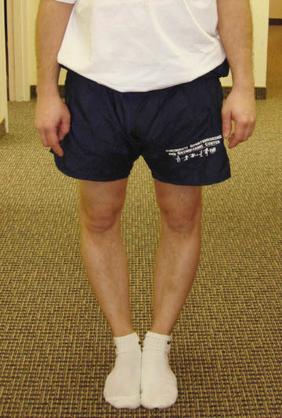
Unfortunately, a prior medial meniscectomy is a major risk factor for progression of arthritis in these knees. Because any underlying arthritis is expected to progress, it is advisable to perform HTO while the joint damage is in the early stages before the development of severe articular cartilage deterioration and loss of tibiofemoral joint space.
One advantage of performing HTO in young patients who have early medial tibiofemoral arthritis after medial meniscectomy is the opportunity to also perform a meniscus transplant and a cartilage restoration procedure if indicated.
The appropriate level of physical activity that can be recommended after HTO remains questionable. Patient education is important so that activity limitations to be followed postoperatively are well understood. The goal of the osteotomy is to allow an active, pain-free lifestyle that includes low-impact recreational pursuits but not high-loading athletics that involve twisting, jumping, and pivoting.
The majority of patients who undergo HTO are age 50 years or younger with varus malalignment and mild to moderate medial tibiofemoral joint arthritis. Many patients have had a prior medial meniscectomy. Patients older than 60 years are usually candidates for partial or total joint replacement. The difficult decision is the treatment recommendation for patients between 50 and 60 years old. With the increasing longevity of unicompartmental knee replacements, patients who have advanced medial compartment damage with major areas of bone exposure will likely experience symptoms after HTO and are better candidates for partial replacement. Individuals who undergo a unicompartmental replacement may participate in recreational activities similar to those who undergo HTO. Osteotomy is performed in patients 50 years old and younger who are athletically active, have remaining medial tibiofemoral cartilage (although thinned), and wish to maintain reasonable athletic pursuits such as tennis and skiing. These patients have early medial compartment symptoms; however, the joint damage is not advanced to a bone-on-bone state that would warrant unicompartmental replacement. Careful patient selection is the key issue, and the surgeon should not overstate or guarantee results of an HTO because the arthritis will eventually progress. In short, the goal of an HTO is to buy time in younger-aged patients (hopefully 10-15 years) before joint replacement. If there is any question that the arthritis of the medial tibiofemoral compartment is advanced to the point where the HTO will not last 10 years, it is preferable in patients age 50 years or older to perform a partial replacement. This is particularly true for sedentary patients in whom the goals of ambulating activities are achieved with partial joint replacement, avoiding the more prolonged postoperative recovery from an HTO.
There exists a group of varus-angulated knees with associated symptomatic ligament deficiencies requiring reconstruction. These ligament deficiencies most commonly involve the anterior cruciate ligament (ACL) and posterolateral structures (fibular collateral ligament [FCL], popliteus muscle-tendon-ligament unit [PMTL] and posterolateral capsule). In these double and triple varus knees, a normal axial alignment must be achieved before proceeding with ligament reconstructive procedures. Lower limb varus malalignment is not overcorrected to valgus when there is no damage to the articular cartilage in the medial tibiofemoral compartment. The goal in these patients is to correct the varus to a neutral alignment and then proceed in a staged manner with a cruciate and posterolateral reconstruction as required. Correction of the varus alignment decreases the risks of failure of the ligament reconstructive procedures.
Medial tibiofemoral compartment bone exposure over an area >15 × 15 mm on femur and tibia
Major concavity medial tibial plateau, loss of bone stock
No joint space in medial compartment on standing 45-degree PA radiographs
Patients 50-60 years old with advanced medial compartment damage (candidates for unicompartmental knee replacement)
Patient >60 years old (candidates for partial or total joint replacement)
>10 degrees of limitation of knee flexion
>10 mm of lateral tibial subluxation
Prior total lateral meniscectomy, lateral tibiofemoral cartilage damage
Use of products containing nicotine
Obesity (body mass index >30)
Increased slope to affected medal tibial plateau; teeter-totter knee
Marked symptomatic and advanced patellofemoral arthrosis
Prior joint infection, diabetes, rheumatoid arthritis, autoimmune diseases, malnutrition state
One commonly debated issue regarding contraindications to osteotomy is the extent of damage to the medial tibiofemoral compartment. In general, HTO is avoided in knees in which there is more than a 15 × 15 mm area of exposed bone on both the tibial and femoral surfaces. There are knees in younger patients in which the area of exposed bone may be greater and partial replacement is not an option. However, as a general rule, remaining articular cartilage should be present over the majority of the medial joint surfaces.
Major concavity of the medial tibial plateau with loss of bone stock is a contraindication to HTO. On standing 45-degree posteroanterior (PA) radiographs, knees that demonstrate no remaining articular cartilage space to the medial compartment are not candidates. An arthroscopic procedure just before HTO helps to assess the amount of remaining articular cartilage and remove symptomatic meniscus fragments and other tissues.
Additional contraindications are a limitation of knee flexion (>10 degrees), lateral tibial subluxation (>10 mm), prior lateral meniscectomy, or lateral tibiofemoral joint damage.
An absolute contraindication for a medial opening wedge osteotomy is the use of nicotine products in any form. The complication of a nonunion is not worth the risk, and a minimum of 8 to 12 weeks of abstinence before surgery is required. The patient is warned that there may still be an increased risk in regard to osteotomy healing.
A relative contraindication is a body weight over 200 lb (91 kg; Fig. 26-2 ). Although there may be some patients in whom HTO is indicated that weigh up to 225 lb (102 kg), this operation is avoided in patients with a higher body weight because the beneficial effect of unloading the medial compartment will not be achieved.
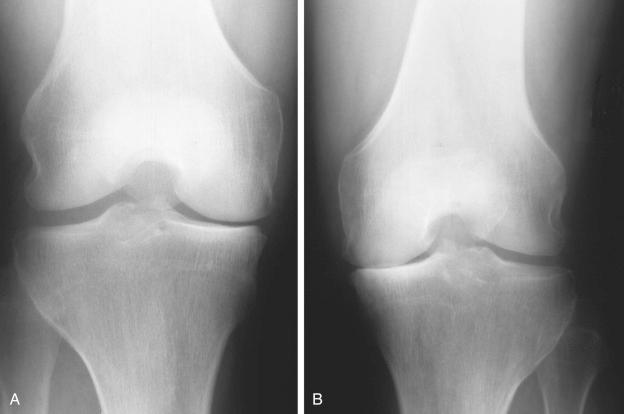
A relative contraindication is increased medial slope to the affected medial tibial plateau in the coronal plane because of advanced medial plateau concavity. This finding indicates that it will not be possible to significantly unload the medial compartment with HTO, and the joint will remain with all of the weight bearing confined to the medial compartment. This problem can be tested before surgery with varus-valgus stability tests at 30 degrees of knee flexion. In knees with advanced medial arthritis, there is no neutral point in which there is simultaneous contact of the medial and lateral compartments. The tibia behaves like a teeter-tooter, with contact alternating between the medial and the lateral compartment and obvious separation of the noncontacted compartment.
The issue of concurrent patellofemoral arthritis has been addressed by prior studies. In general, the symptomatic state should be addressed and the patient warned preoperatively that patellofemoral symptoms may continue or progress. Marked patellofemoral symptoms contraindicate a HTO. The finding of asymptomatic articular cartilage changes to the patellofemoral joint is not a contraindication to HTO because clinicians have noted that the end result in terms of longevity of the HTO depends on the symptomatic medial tibiofemoral compartment.
Medical contraindications to HTO include diabetes, rheumatoid arthritis, autoimmune diseases, and malnutrition states.
Primary varus: amount of varus angulation caused by physiologic tibiofemoral angulation and osteocartilaginous (narrowing) of the medial tibiofemoral compartment
Double varus: amount of varus angulation caused by:
Tibiofemoral osteocartilaginous and geometric alignment
Separation of the lateral tibiofemoral compartment from moderate deficiency of the posterolateral structures (>5 mm increased lateral joint opening, 10 degrees increased external tibial rotation)
Triple varus: amount of varus angulation caused by:
Tibiofemoral osteocartilaginous and geometric alignment
Separation of the lateral tibiofemoral compartment
Varus recurvatum in extension, severe deficiency posterolateral ligamentous structures
Restraints resisting lateral tibiofemoral compartment separation under dynamic weight-bearing conditions: quadriceps, biceps femoris, gastrocnemius, iliotibial band
An added complexity in the varus-angulated knee with medial compartment arthritis is the presence of ACL deficiency. An associated deficiency of the posterolateral structures may add to the varus angulation and clinical symptoms. Patients who have these combined abnormalities often experience pain, swelling, giving way, and functional limitations that may result in a disabling condition. In these complex knees, multiple abnormalities exist to the lower limb and knee joint that must be correctly diagnosed to outline a rational treatment program. These include the anatomic tibiofemoral osseous coronal and sagittal alignment, abnormal knee motion limits, abnormal knee positions (subluxations of the medial and lateral tibiofemoral compartments), and the corresponding specific deficiencies of the ligament structures (single and combined).
The terms primary varus , double varus , and triple varus knee were devised to classify varus-aligned knees with associated ligament deficiencies ( Table 26-1 ). This classification system is based on the underlying tibiofemoral osseous alignment and the additional effect of separation of the lateral tibiofemoral compartment (because of deficiency of the posterolateral structures) on the overall varus lower limb alignment, as calculated from the WBL.
| Tibiofemoral Alignment or Geometry | Knee Motion Limits | Knee Joint Position | Ligament Deficiency | Comments |
|---|---|---|---|---|
| Primary varus Physiologic tibiofemoral varus alignment; narrowing or loss of medial joint cartilage | NA ↑ Varus or adduction rotation |
NA ↓ Separation of medial tibiofemoral compartment |
NA Pseudolaxity or slackness of medial ligament structures |
Medial displacement of weight-bearing tibiofemoral line. Effect on varus alignment is more pronounced when preexisting physiologic varus alignment is present. |
| Double varus Added deficiency of FCL, posterolateral soft tissue structures | ↑↑ Varus or adduction rotation Often coupled with lateral tibial translation and secondary support, intercondylar eminence against lateral femoral condyle |
Separation of lateral tibiofemoral joint on standing Varus thrust on walking caused by lateral condylar lift-off Increased tension in FCL, posterolateral soft tissues |
FCL, lateral capsule, iliotibial band (femorotibial portion) Amount of joint opening depends on slackness of lateral soft tissue restraints Absence of ACL secondary restraint to varus angulation |
Weight-bearing tibiofemoral line shifts far enough medially to produce separation of the lateral tibiofemoral joint during walking, sports activities. Under states of maximal muscle contraction (quadriceps, biceps femoris), sufficient compressive forces may exist to prevent lateral condylar lift-off. |
| Triple varus Added deficiency of all PL structures (FCL, PMTL, PL capsule) | ↑↑↑ Varus or adduction rotation Varus recurvatum in extension: Increased external tibial rotation Increased hyperextension Increased external tibial rotation in flexion |
↑ Separation of lateral compartment plus varus recurvatum may occur on standing, walking Varus recurvatum thrust if quadriceps and ankle plantar flexors do not prevent knee hyperextension Posterior subluxation of lateral plateau with external tibial rotation |
As above, plus PMTL, PL capsule Knee hyperextension increases with associated damage to ACL, PCL (partial to complete) |
Gait training is required to teach patient not to walk with varus recurvatum thrust, maintaining 5 degrees of knee flexion on initial weight bearing. Knee hyperextension with physiologic slackness to ACL and PCL may be present without actual injury to cruciates allowing varus recurvatum. |
In patients with a varus-angulated knee, a bilateral physiologic varus tibiofemoral alignment is usually present. In others, a normal tibiofemoral alignment may convert to a varus malalignment after medial meniscectomy. With loss of the medial meniscus and resultant articular cartilage deterioration, narrowing of the medial tibiofemoral compartment occurs along with an increase in varus lower limb alignment. For example, a patient with a physiologic varus alignment of 3 degrees (mechanical axis) with an additional loss of 3 mm of the medial articular cartilage would develop an overall 6 degrees varus tibiofemoral alignment.
The term primary varus refers to the physiologic tibiofemoral osseous angulation and any further increase in angulation owing to altered geometry (narrowing) of the medial osteocartilaginous tibiofemoral joint ( Fig. 26-3 ). The tibiofemoral WBL shifts into the medial tibiofemoral compartment as the narrowing progresses and the lateral compartment is unloaded. Three degrees of varus angulation approximately doubles medial compartment pressures.
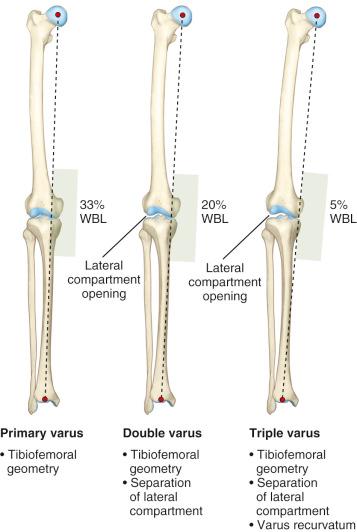
As the WBL shifts into the medial compartment, there are increased tensile forces in the posterolateral soft tissues, including the iliotibial tract and ligament structures. There is corresponding separation of the lateral tibiofemoral compartment during standing, walking, and running activities (lateral condylar lift off). This is called a double varus knee because the lower limb varus malalignment results from two factors: the tibiofemoral osseous and geometric alignment and separation of the lateral tibiofemoral compartment from deficiency of the posterolateral structures.
A combination of active and passive restraints resists separation of the lateral tibiofemoral compartment under dynamic loading conditions. The quadriceps, biceps femoris, and gastrocnemius muscles and iliotibial band act in a dynamic manner to resist adduction moments at the knee joint during gait, and with weight-bearing loads, resist lateral tibiofemoral separation. If these muscle forces do not provide a functional restraint to excessive lateral tensile forces, separation of the lateral tibiofemoral joint occurs.
The FCL normally allows a few millimeters of separation of the tibiofemoral compartment, and pathologic stretching (interstitial injury) may occur to this ligament in chronic varus-angulated knees. Under these circumstances, a transfer of all of the weight-bearing loads to the medial compartment occurs, which can be especially deleterious if damaged articular cartilage or prior meniscectomy is present.
The patient symptoms commonly increase with pain in both the medial compartment and lateral aspect of the knee joint owing to excessive medial compressive and lateral soft tissue tensile forces, respectively.
In a triple varus knee, injury to the FCL and posterolateral structures produces a varus recurvatum position of the limb. A triple varus knee results from three causes: tibiofemoral varus osseous malalignment, increased lateral tibiofemoral compartment separation caused by marked insufficiency of the FCL and PMTL, and varus recurvatum in extension. The varus recurvatum occurs because of abnormal external tibial rotation and knee hyperextension, reflecting deficiency of the posterolateral structures and possibly the ACL. Owing to the increase in lateral compartment opening, the WBL shifts further medially as shown in Figure 26-3 .
HTO is indicated in patients with varus malalignment who demonstrate a varus thrust on walking. An ACL reconstruction in these knees would not address the instability and would be expected to fail if the varus osseous malalignment was not first corrected owing to the abnormal lateral tibiofemoral joint opening. A varus recurvatum or back-knee instability indicates a triple varus knee in which the posterolateral structures require reconstruction along with the ACL, after first correcting the osseous malalignment.
Eckhoff and coworkers reported important 3-dimensional measurements in 90 individuals (180 limbs) and showed that there is considerable variation in coronal alignment between subjects and between right-left lower limbs ( Fig. 26-4 ). One qualification to the data is that the hip-knee-ankle computed tomography (CT) measurements were obtained under non–weight-bearing conditions.
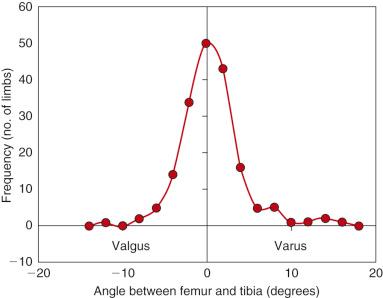
Given the variation in lower limb alignment in individuals, a frequent question is what is the effect of correcting one limb to neutral or a mild valgus overcorrection on overall gait and the (unoperated) opposite limb, particularly when a marked varus alignment is present bilaterally. In our experience, the opposite extremity does not require HTO, except in a small percentage of patients who have marked bilateral varus alignment and medial tibiofemoral pain.
Moments and loads on knee joint cannot be reliably predicted from static measurement of lower limb alignment on radiographs. Abnormally high knee adduction moments increase the risk for progression of medial tibiofemoral arthrosis. Success of HTO is related to lowering abnormal moments to normal or below-normal values.
Our study conclusions:
Majority ACL-deficient varus-angulated knees have abnormally high adduction moments on walking.
One third of patients have normal or low adduction moments, normal to low medial tibiofemoral compartment loads. Gait characteristics/adaptations lowered medial tibiofemoral loads despite varus angulation.
Significant correlation between high adduction moments and high medial tibiofemoral compartment loads, high lateral soft tissue forces.
In knees with high lateral ligament tensile forces, separation of the lateral tibiofemoral joint may occur with “condylar lift-off” during weight bearing.
Large tensile loads on posterolateral tissues cause stretching, deficiency (double and triple varus knees), and failure of posterolateral reconstructive procedures.
Although a high adduction moment may be anticipated as a result of varus malalignment, the moments and loads on the knee joint cannot be reliably predicted from the static measurement of lower limb alignment on radiographs. Many factors in patients with ACL-deficiency, varus malalignment, and posterolateral deficiency can be assessed by gait analysis. Abnormal limb alignment, either varus or valgus in the coronal plane or hyperextension in the sagittal plane, produces substantial alterations in the moments and forces about the knee joint ( Fig. 26-5 ). The analysis of external moments about the knee during gait allows the clinician to understand the effect of the altered gait dynamics on the knee joint. Abnormally high knee adduction moments increase the risk for progression of medial tibiofemoral arthritis owing to excessive loading. The success of HTO has been related to lowering these moments to below normal values. In addition, gait analysis allows calculation of abnormally high tensile forces in the lateral soft tissue restraints that increase the risk of elongating these tissues from lateral condylar lift-off with activity. Abnormal tensile loads on posterolateral soft tissues preclude successful FCL and PMTL reconstruction. Markholf and associates reported that lateral tibiofemoral compartment condylar lift-off had a marked effect on producing joint instability.
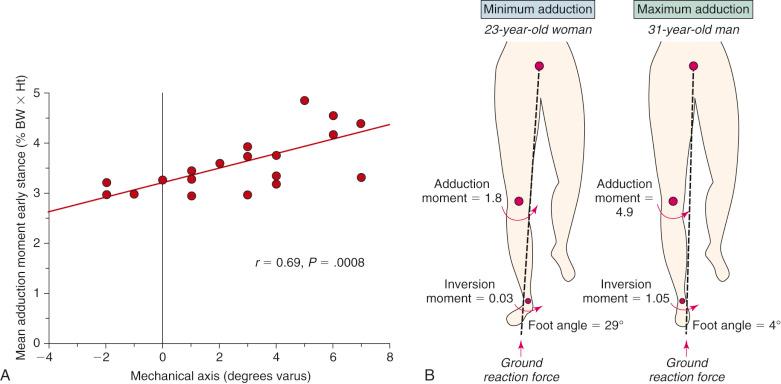
Many studies have documented that the external moments about the knee joint and the corresponding tibiofemoral compartment loads are markedly influenced by individual gait characteristics and adaptations that occur after injury. ACL deficiency may produce marked abnormalities in moments about the knee joint in the sagittal plane, which is further affected by lower limb varus malalignment. Patients with ACL deficiency may show a decrease in the magnitude of the external flexion moment (quadriceps-reduced gait) or an increase in the external extension moment (hamstrings-protective muscle force). These effects are discussed in Chapter 6 . The alignment of the foot markedly influences the knee adduction moment. Patients with toe-in, or less than normal external axial rotation of the foot during stance phase, tend to have a higher knee adduction moment as the WBL passes farther medial to the knee joint.
Gait analyses were conducted in a study at our institution involving 32 patients with ACL deficiency and varus angulation. A force plate and optoelectronic system were used to measure forces and moments of the lower limb and knee joint. Knee joint loads and ligament tensile forces were calculated using a previously described mathematical model. Sixty-two percent of the patients had an abnormally high magnitude of the moment, tending to adduct the affected knee ( Fig. 26-6 ). The calculated medial tibiofemoral loads were excessively high in 66% of the patients ( P < .01). Forty-seven percent of the patients had predicted abnormally high lateral ligament tensile forces ( P < .05). The adduction moment showed a statistically significant ( P < .05) correlation to predicted high medial tibiofemoral compartment loads and high lateral ligament tensile forces ( P < .01). A shift had occurred in the center of maximal joint pressure to the medial tibiofemoral compartment, with a corresponding increase in the lateral ligament tensile forces to achieve frontal plane stability ( Figs. 26-7 and 26-8 ). If muscle forces are not sufficient to maintain lateral tibiofemoral compressive loads, tensile forces develop in the lateral ligament tissues. The data indicate that in knees with high lateral ligament tensile forces, separation of the lateral tibiofemoral joint occurs with condylar lift-off during weight bearing.
![FIG 26-6, The distribution of the adduction moments during walking in the anterior cruciate ligament–deficient knees. The cutoff value (3.30, % body weight [BW] × height [Ht]) represents the control mean minus 1 standard deviation. FIG 26-6, The distribution of the adduction moments during walking in the anterior cruciate ligament–deficient knees. The cutoff value (3.30, % body weight [BW] × height [Ht]) represents the control mean minus 1 standard deviation.](https://storage.googleapis.com/dl.dentistrykey.com/clinical/TibialandFemoralOsteotomyforVarusandValgusKneeSyndromesDiagnosisOsteotomyTechniquesandClinicalOutcomes/5_3s20B9780323329033000263.jpg)
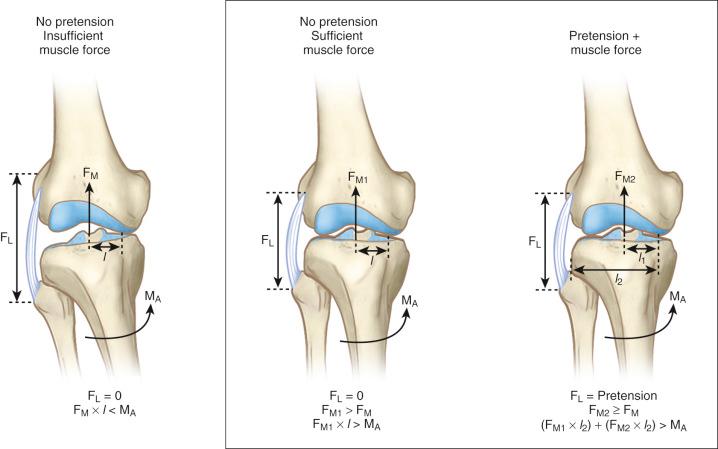
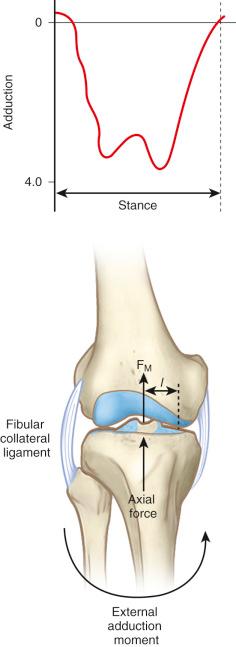
The magnitude of the flexion moment (which is related to quadriceps muscle force) was significantly lower in 47% of the patients ( P < .05), and the extension moment (related to hamstring muscle force) was significantly higher in 50% ( P < .05). These findings indicated that a gait adaptation occurred that diminished quadriceps muscle activity and enhanced hamstring muscle activity hypothesized to provide anteroposterior (AP) stability in these ACL-deficient knees.
Equally important in the results was the finding that approximately one third of the patients had normal or low adduction moments and corresponding normal to low medial tibiofemoral compartment loads. These patients had gait characteristics or adaptations that lowered medial tibiofemoral loads despite the varus lower limb alignment. Gait analysis allowed identification of patients with a potentially better overall prognosis; the adduction moment and medial tibiofemoral loads were not excessively high, and an HTO would result in a substantial lowering of the loads placed on the medial tibiofemoral joint.
We studied patients with varus-angulated knees with insufficient posterolateral structures in whom prior posterolateral reconstructive procedures failed and an HTO was required before further soft tissue reconstructive procedures could be done. One explanation for these clinical findings is that these knees had a varus or hyperextension thrust during the stance phase of gait, which placed undue tensile forces on the deficient posterolateral structures ( Fig. 26-9 ). Untreated varus malalignment has also been identified as a predisposing cause of failure of ACL reconstructions and posterior cruciate ligament (PCL) reconstructions as well.

Knee flexion and extension
Joint effusion
Patellofemoral: extensor mechanism malalignment
Tibiofemoral crepitus, joint line pain, compression pain, inflammation
Gait abnormalities
Abnormal knee motion limits and subluxations
Posterior drawer, 90 degrees of knee flexion
KT-2000, 20 degrees of knee flexion, 189-N force
Pivot shift, Lachman
Lateral and medial tibiofemoral joint opening at 0 and 25 degrees of knee flexion
Varus recurvatum: supine
30 and 90 degrees of knee flexion
An increase in external tibial rotation represents either a posterior subluxation of the lateral tibial plateau (injury to the posterolateral structures) or anterior subluxation of the medial tibial plateau (injury to the medial collateral ligament and posteromedial structures)
Supine position preferred; difficult to palpate the medial and lateral tibiofemoral position in the prone position
Double-stance, hip-knee-ankle to measure mechanical axis, WBL, lateral compartment separation
Lateral, 30 degrees of knee flexion (patellar height measurement)
PA, weight bearing, 45 degrees of knee flexion
Patellofemoral axial
Lateral stress, neutral tibial rotation, tibia unconstrained, 67-N varus force
Patients complete questionnaires and are interviewed for the assessment of symptoms, functional limitations, sports and occupational activity levels, and patient perception of the overall knee condition according to the Cincinnati Knee Rating System (CKRS; see Chapter 41 ).
Symptoms of pain, swelling, and giving way are well recognized consequences of ACL deficiency. However, in a knee with combined varus malalignment and ACL deficiency, several different knee subluxations may produce symptoms of instability. These include anterior subluxation of the tibia, separation of the lateral tibiofemoral compartment on walking (varus thrust), posterior subluxation of the lateral tibial plateau (with knee flexion and external tibial rotation), and excessive hyperextension or varus recurvatum with a back-knee or feeling of the knee joint going into hyperextension. By history and asking the patient to demonstrate the knee instability, the surgeon must carefully determine the subluxations present.
A complaint of medial joint line pain may or may not correlate with the degree of medial compartment articular cartilage damage. In the early stages, the patient usually complains of medial pain occurring with sports activities but not with daily activities. When pain occurs with daily activities, there is a high likelihood that extensive damage exists to the joint articular cartilage. Loss of the medial meniscus is the major risk factor for the progression of arthritis in the medial compartment.
The physical examination of the knee joint to detect all of the abnormalities in a varus-angulated knee is comprehensive ( Table 26-2 ) and includes assessment of (1) the patellofemoral joint, especially possible extensor mechanism malalignment caused by increased external tibial rotation and posterolateral tibial subluxation; (2) medial tibiofemoral crepitus on varus loading, indicative of articular cartilage damage even if not visible on radiographs; (3) pain and inflammation of the lateral soft tissues caused by tensile overloading; (4) gait abnormalities (excessive hyperextension or varus thrust) during walking and jogging ; and (5) abnormal knee motion limits and subluxations compared with the contralateral knee.
| Abnormality | Diagnostic Test |
|---|---|
| Tibiofemoral alignment | Full-length standing radiograph: double support (closure of lateral tibiofemoral joint required) |
| Narrowing of medial tibiofemoral joint | Change in millimeters from opposite side on 45-degree PA weight-bearing x-ray or stress radiograph |
| FCL insufficiency | Increase in lateral joint opening at 30 degrees of flexion |
| FCL, PMTL, PL capsule insufficiency | Further increase in lateral joint opening at 30 degrees of flexion; increase in external tibial rotation at 30 degrees of flexion; varus recurvatum in extension |
| Lateral tibiofemoral joint separation | Standing radiograph shows increased joint width compared with opposite side; amount of increase on stress radiograph compared with opposite side |
| Varus recurvatum | Defined by degrees of hyperextension and varus angulation; elicited on supine varus recurvatum test. Standing tests with patient assuming maximal knee hyperextension position provides greatest subluxation. Estimate degrees of increase in varus and hyperextension. |
The medial posterior tibiofemoral step-off on the posterior drawer test is done at 90 degrees of flexion ( Fig. 26-10 ). This test is performed first to identify that the tibia is not posteriorly subluxated, indicating a partial or complete PCL tear. A KT-2000 (MEDmetric) arthrometer test may be done at 20 degrees of flexion (134-N force) to quantify total AP displacement. The Lachman test is performed at 20 degrees of knee flexion. The pivot shift test is done and the result recorded on a scale of 0 to III, with a grade of 0 indicating no pivot shift; grade I, a slip or glide; grade II, a jerk with gross subluxation or clunk; and grade III, gross subluxation with impingement of the posterior aspect of the lateral side of the tibial plateau against the femoral condyle.
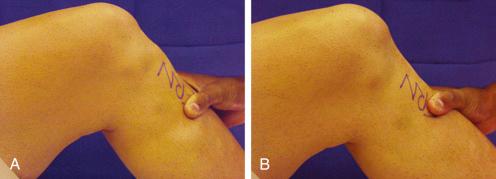
FCL insufficiency is determined by the varus stress test at 0 and 30 degrees of knee flexion (see Fig. 26-10 ). The surgeon estimates the amount of joint opening (in millimeters) between the initial closed contact position of each tibiofemoral compartment, performed in a constrained manner avoiding internal or external tibial rotation, to the maximal opened position. The result is recorded according to the increase in the tibiofemoral compartment of the affected knee compared with that of the opposite normal knee. This comparison is crucial, and it is important to avoid measuring only the degrees of varus or valgus rotation in the involved knee.
An increase in medial joint opening may occur compared with the opposite knee that represents a pseudolaxity because the increase is actually caused by medial tibiofemoral joint narrowing. When the test is conducted under a varus stress, the medial joint opening returns the limb to a more normal alignment, and there is no true medial ligamentous damage. The true amount of medial and lateral tibiofemoral compartment opening is later confirmed during the arthroscopic examination with gap tests. The primary and secondary restraints that resist lateral joint opening have been described previously. The abnormal medial joint opening depends on the knee flexion angle at which the test is conducted and the integrity of the secondary restraints.
The tibiofemoral rotation test was first described by the senior author (F.R.N.) and is used to estimate the amount of posterior tibial subluxation (see Fig. 26-10 ). The test is conducted in the following manner: (1) the tibia is positioned at 30 degrees of knee flexion, in neutral rotation; (2) the position of the anterior aspect of the medial and lateral tibial plateaus are determined in reference to the femoral condyles by palpation; (3) the tibia is externally rotated to its maximum position; (4) the positions of the medial and lateral tibial plateaus are palpated to determine an abnormal posterior subluxation of the lateral compartment or anterior subluxation of the medial compartment; (5) the examiner observes the location of the tibial tubercle to determine any increase in external tibial rotation compared with the opposite normal knee; and (6) the test is repeated at 90 degrees of knee flexion and may also be conducted by starting at the neutral tibial rotation position, progressing to internal tibial rotation.
If an increase in external tibial rotation is present, it represents either a posterior subluxation of the lateral tibial plateau (indicating injury to the FCL and PMTL) or anterior subluxation of the medial tibial plateau (indicating injury to the superficial medial collateral ligament [SMCL] and posteromedial structures). In some knees, both anteromedial and posterolateral subluxations are present.
The tibiofemoral rotation test involves close observation of the location of the internal and external tibial rotation axis and comparison of the location of this axis with that in the normal knee. With posterior subluxation of the lateral tibial plateau during external tibial rotation, the examiner may detect a shift in the axis of tibial rotation to the medial tibiofemoral compartment. Alternatively, with an anterior subluxation of the medial tibial plateau, the center of tibial rotation shifts to the lateral tibiofemoral compartment as the maximal external tibial rotation position is reached.
The advantages of the tibiofemoral rotation test over the traditional posterolateral drawer test are (1) the knee may be positioned at varying flexion positions (30 and 90 degrees); (2) the tibia is less constrained because the foot is not held fixed to the examining table; and (3) the axis of tibial rotation can be observed as the tibia is rotated externally and internally. More information is gained when the tibiofemoral rotation tests are performed in a supine position. In the prone position, it is difficult to palpate the medial and lateral tibiofemoral position required to diagnose the abnormal compartment subluxations. The only indication for the prone dial test is a PCL-deficient knee in which the tibia can be gently displaced to a reduced anterior position during the rotation tests. In the supine position, the tibia can also be displaced anteriorly to prevent posterior subluxation, which makes the interpretation of the dial test more difficult.
A varus recurvatum test in both the supine and standing positions and the reversed pivot shift test are included in the assessment of posterolateral tibial subluxation. However, these represent qualitative tests that are difficult to measure in objective terms. Still, they provide useful information regarding the magnitude of the overall subluxation of the knee joint when two or more abnormal motion limits are present.
Radiographic assessment of lower limb alignment is based on full-length radiographs of the extremity with the patient in the standing position. Separation of the lateral tibiofemoral compartment may occur, preventing a correct assessment of true tibiofemoral osseous alignment. Double-stance, full-length AP radiographs showing both lower extremities from the femoral heads to the ankle joints are obtained. The knee is flexed 3 to 5 degrees to avoid a hyperextension position, and the foot angle is set to approximately 10 to 12 degrees. If separation of the lateral tibiofemoral joint is observed on radiographs, it is necessary to subtract the lateral compartment opening so that the true tibiofemoral osseous alignment is determined and a valgus overcorrection at surgery is avoided as is discussed under Preoperative Planning.
During varus-valgus testing at 30 degrees of flexion, the clinician should assess for a possible teeter-totter effect, in which simultaneous contact of the medial and lateral tibiofemoral compartments is not possible owing to advanced tibial obliquity and bone loss of the medial tibiofemoral joint.
Additional radiographs taken during the initial examination include a lateral at 30 degrees of knee flexion, weight-bearing PA at 45 degrees of knee flexion, and patellofemoral axial views. Telos medial or lateral stress radiographs may be required in select knees ( Fig. 26-11 ).
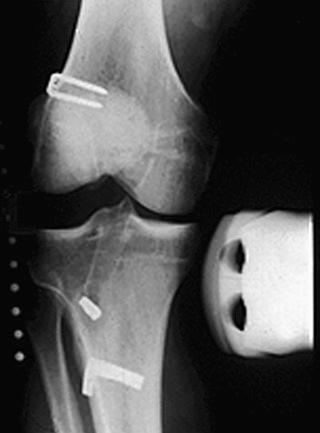
The height of both patellas is measured on lateral radiographs ( Fig. 26-12 ) to determine whether or not an abnormal patella infera or alta position exists that may be a factor in selecting an opening or closing wedge osteotomy, which would further decrease or elevate the patella position.
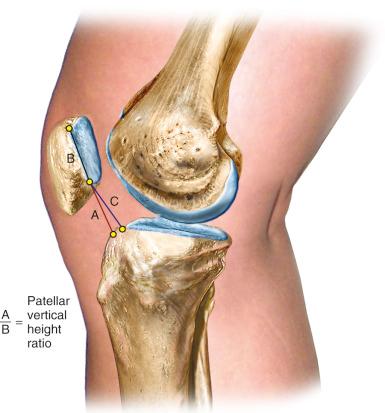
The clinical algorithm for the preoperative clinical and radiographic assessment to determine candidates for either a medial opening wedge or lateral closing wedge osteotomy is shown in Figure 26-13 .
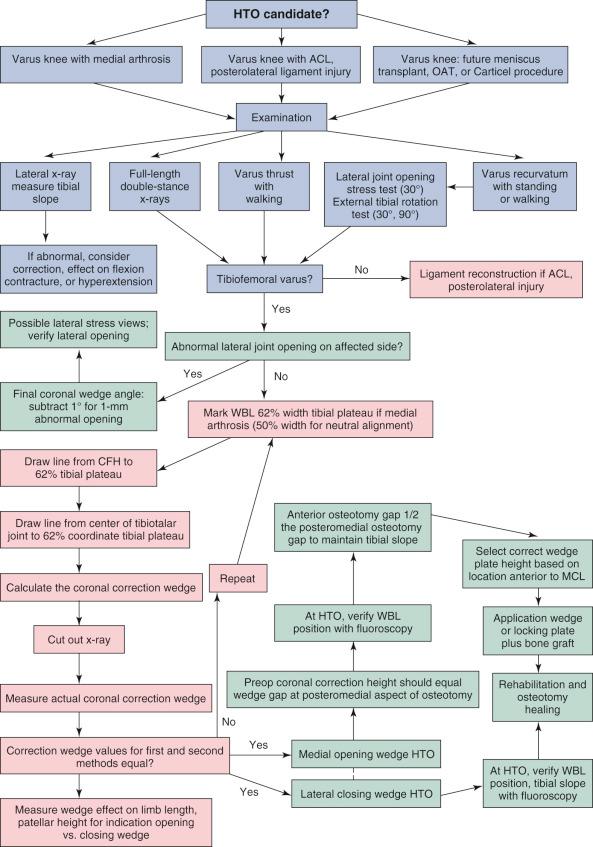
Determine angular correction to achieve redistribution of tibiofemoral forces without altering tibial slope.
Take into account abnormal lateral tibiofemoral separation from deficient posterolateral structures.
Measure WBL on bilateral standing hip-knee-ankle radiographs. WBL is dependent on femoral and tibial lengths and angular deformity.
Measure tibial slope on lateral radiographs.
Increasing tibial slope increases anterior tibial translation and potentially tensile loads on the ACL.
Decreasing tibial slope increases posterior tibial translation and potentially tensile loads on PCL.
Do not alter normal tibial slope unless it is abnormal (>2 standard deviations above normal).
Do not alter a normal tibial slope in ACL- or PCL-deficient knees.
Maintain normal tibial slope: anterior gap at medial opening wedge should be half the posteromedial gap. Every millimeter of anterior gap change = 2 degrees change in tibial slope.
Cruciate reconstruction with HTO or later (no abnormal lateral joint opening present)
HTO first
Posterolateral structures may shorten with valgus alignment
Perform cruciate, posterolateral reconstructions later if required
HTO first; cruciate and posterolateral reconstruction later
Avoids lateral dissection, fibular osteotomy
Large correction >12 degrees, avoids tibial shortening
Distal advancement or reconstruction of the MCL in chronic MCL ruptures
In subsequent posterolateral reconstructions, avoids proximal fibular osteotomy, allows FCL grafts to be fixated securely to proximal fibula
Faster healing
Earlier resumption of weight bearing
Superior strength initial osteotomy fixation
Decreased risk early loss of correction, nonunion
More difficult to achieve correction at surgery
Large closing wedge may elevate patellar height and decrease lower limb length; reverse applies with opening wedge
Opening wedge angle is dependent on the angle of coronal valgus correction and the angle of obliquity of the anteromedial tibial cortex.
Every millimeter of alteration in anterior gap height results in a change of 2 degrees in tibial slope.
The preoperative calculations for HTO involve measurements to determine the amount of angular correction desired to redistribute tibiofemoral forces while not altering tibial slope and tibiofemoral joint obliquity in the frontal plane. The radiographic measurement and correction may require alteration at surgery with fluoroscopic analysis, as described. The normal tibiofemoral coronal alignment is shown in Figure 26-14 . In varus angulated knees, there is a slight increase in obliquity caused by medial tibiofemoral joint arthrosis principally involving the medial condyle.
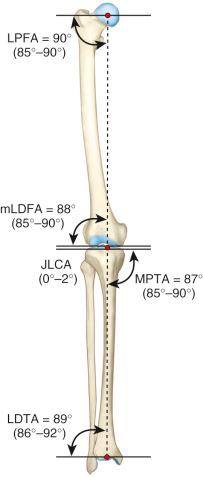
An undercorrection or overcorrection in the coronal plane may result if the surgeon fails to recognize the effect of lateral tibiofemoral separation on increasing varus angulation from slack or deficient lateral soft tissues. Inaccurate calculations may also arise from failure to use the WBL from double-stance, full-length, standing radiographs of both lower extremities. A single-stance radiograph of the affected limb will show the maximum varus angulation caused by lateral condylar lift off; however, this should not be used for osteotomy calculations. A double-stance radiograph helps close the lateral tibiofemoral compartment so the osseous alignment is calculated, which is required for surgical correction.
Sabharwal and Zhao compared lower limb coronal alignment on full-length, standing radiographs to supine intraoperative hip-knee-ankle fluoroscopy measurements in 102 limbs. There was a statistically significant mean difference between the two techniques (mean, 13.4 mm deviation in the WBL, measured from the center of the joint). This difference in the two techniques is of concern in the preoperative planning and the final intraoperative osteotomy correction in the coronal plane. There was no description of the effect of abnormal lateral joint opening on the standing radiographs that may account for errors in preoperative measurements. Furthermore, during surgery there was no description of the fluoroscopy technique. The surgeon must verify medial and lateral tibiofemoral joint contact to account for possible opening of the medial or lateral tibiofemoral joint during the WBL measurement.
The fluoroscopy technique during HTO involves the surgeon placing an axial load against the foot to overcome medial or lateral joint opening, which is verified by the fluoroscopic image. The lower extremity should be held in 10 degrees of knee flexion and approximately 10 to 12 degrees of external rotation (hip to ankle axial alignment simulating foot progression angle). The limb alignment rod at the knee joint can be observed to move medial to lateral with internal to external limb rotation, which is another source of error in measuring the WBL intersection at the tibia. This is because the alignment rod is placed anterior to the true center of axial rotation at the ankle joint, and therefore lower limb rotation induces this error. One advantage of the computerized navigation technique is that the WBL is centered through the hip-knee-ankle joints, and an alignment rod or cord used at surgery is placed anterior to these respective joints.
An example of the potential effect of the failure to account for increased lateral joint opening is shown in Figure 26-15 . The case represents a 38-year-old man whose full-length, standing radiograph shows a varus angular deformity (mechanical axis) of 7 degrees and a 4-mm increase in lateral joint opening. The width of the tibial plateau is 81 mm. The equation to determine the angular deformity resulting from the lateral tibiofemoral separation distance is:
Therefore, in this patient, the calculated amount of varus angular deformity caused by the lateral joint opening increase of 4 mm is 76.4 (4 mm)/81 mm = 3.7 degrees, or approximately 1 degree/mm increased lateral joint separation. Failure to account for the lateral joint opening would result in approximately 4 degrees of valgus overcorrection after HTO, assuming closure of the lateral tibiofemoral joint ( Fig. 26-16 ). A WBL crossing the knee lateral to the 75% coordinate has the potential for a lift off of the medial femoral condyle and a cosmetic abnormal valgus alignment. Unicondylar weight bearing resulting from distraction of the medial compartment is undesirable and could result in subsequent arthritis of the lateral compartment, MCL laxity, and a progressive valgus deformity ( Fig. 26-17 ). The WBL–tibial intersection depends on the coronal mechanical axis angle and the femoral and tibial lengths of the patient; the senior author's published study showed the WBL axis to be more accurate than the anatomic axis for osteotomy correction.
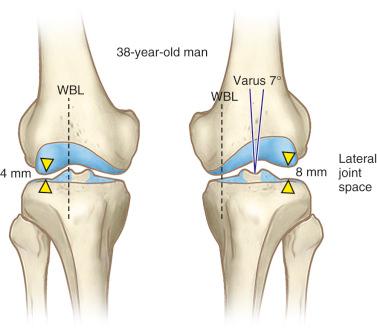

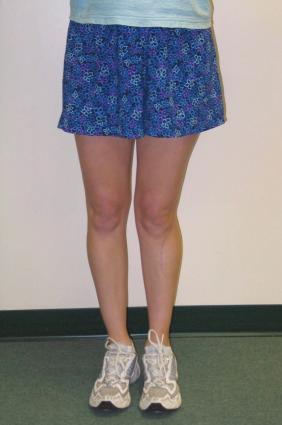
Two methods are used to determine the correction wedge on preoperative radiographs. First, the centers of the femoral head and tibiotalar joint (center of the talus) are marked on the full-length radiograph ( Fig. 26-18 ). The desired correction in the WBL coordinate of the tibial plateau is identified and marked. This is usually placed at 62% of the tibial width (just at the down slope of the lateral tibial spine), which allows the WBL to pass through the lateral tibiofemoral compartment, providing a 2 to 3 degrees of angular valgus overcorrection. The 62% WBL coordinate is used if there is medial tibiofemoral articular cartilage damage, and the intention is to transfer major loads to the lateral compartment. A 50% to 54% WBL coordinate is chosen if there is no medial tibiofemoral joint damage and the surgeon wishes to correct to a neutral axial alignment (e.g., before posterolateral reconstruction). One line is drawn from the center of the femoral head to the selected percent WBL intersection at the tibia, and a second line is drawn from the center of the tibiotalar joint to the same tibial coordinate position. The angle formed by the two lines intersecting at the tibia represents the angular correction required to realign the WBL through this coordinate. An alternative method was published in which the previously discussed femoral and tibial axis lines intersect at the hinge point of the tibial osteotomy. This technique ends up with a similar measurement for the angular correction. However, the surgeon does not have the measured WBL tibial intersection required for intraoperative fluoroscopy verification.
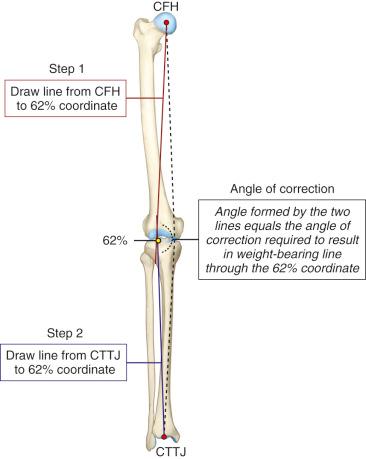
The second method of determining the correction wedge involves cutting the full-standing radiograph horizontally through the line of the superior osteotomy cut ( Fig. 26-19 ). A vertical cut of the lower tibial segment (opening or closing wedge) is made to converge with the first cut. The distal portion of the radiograph is aligned until the center of the femoral head, the selected WBL coordinate point on the tibial plateau, and the center of the tibiotalar joint are all collinear. With the radiograph taped in this position, the angle of the wedge formed by the overlap of the two radiographic segments is measured and compared with the value obtained using the first method. The mechanical axis is measured to determine the angular correction. If there is a discrepancy between the two correction wedge angles, the procedures should be repeated.
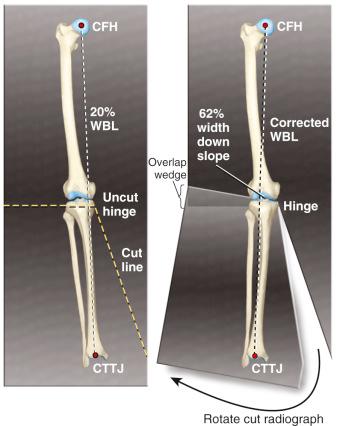
Lateral radiographs are examined and measurements made of the tibial slope. Abnormal posterior sloping of the tibia in the sagittal plane may occur after tibial osteotomy, tibial fractures, growth abnormalities, or rarely, as a congenital abnormality.
Several methods have been reported to measure the medial and lateral tibial slope based on lateral tibial radiographs ( Table 26-3 ). Each method results in different slope values for the same tibia ( Fig. 26-20 ), and all studies show high standard deviations and ranges, indicating that tibial slope may show variation among individual patients. Brazier and colleagues measured 83 lateral knee radiographs and concluded that the methods of slope measurement of proximal tibial anatomic axis (PTAA) and posterior tibial cortex were more reliable than other methods. Genin and coworkers and Julliard and associates recommended using the tibial mechanical axis to represent the true tibial slope. The PTAA is our preferred method for HTO, and the anterior tibial cortex measurement is used when cutting the proximal tibia during total knee arthroplasty (TKA).
| Study | Gender/Group | Measurement | MEDIAL SLOPE (DEGREES) | LATERAL SLOPE (DEGREES) | ||
|---|---|---|---|---|---|---|
| Mean ± SD | Range | Mean ± SD | Range | |||
| Stijak et al (2008) | ACL deficient, men and women | PTAA | 5.24 ± 3.60 | NA | 7.52 ± 3.39 | NA |
| Patellofemoral pain, men and women | 6.58 ± 3.21 | NA | 4.36 ± 2.26 | NA | ||
| Meister et al (1998) | ACL deficient | PTAA | 9.7 ± 1.8 | NA | NA | NA |
| Patellofemoral pain | 9.9 ± 2.1 | NA | NA | NA | ||
| Hohmann et al (2010) | ACL deficient, men and women | PTC | 6.10 ± 3.57 | 0-17 | NA | NA |
| ACL reconstructed, men and women | 7.20 ± 4.49 | 0-17 | NA | NA | ||
| Hohmann et al (2011) | ACL deficient, men | PTC | 5.5 ± 3.4 | 0-16 | NA | NA |
| ACL deficient, women | 6.7 ± 3.7 | 0-17 | NA | NA | ||
| Control, men | 5.8 ± 3.1 | 1-14 | NA | NA | ||
| Control, women | 5.0 ± 3.4 | 1-15 | NA | NA | ||
| Jiang et al (1994) | Men and women | PTAA | 10 ± 4 | 0-20 | NA | NA |
| Matsuda et al (1999) | Varus-angulated knees, men and women | PTAA | 9.9 | 1.5-19 | 6 | 1-13 |
| Normal-angulated knees, men and women | 10.7 | 5-15.5 | 7.2 | 0-14.5 | ||
| Billings et al (2000) | Varus-angulated knees, men and women | TSA | 8.7 ± 4.31 | NA | NA | NA |
| Yoshioka et al (1989) | Men | Mechanical axis * | 7 ± 2.2 | NA | 8 ± 3.8 | NA |
| Women | 7 ± 3 | NA | 7 ± 3.9 | NA | ||
| Julliard et al (1993) | Men and women | Mechanical axis * | 7.03 ± 3.17 | −2 to +19 | NA | NA |
| Genin et al (1993) | Men and women | Mechanical axis * | 7.03 ± 3.17 | −1 to +18 | NA | NA |
| ATC | 7.9 ± 3.2 | −1 to +18 | NA | NA | ||
| Chiu et al (2000) | Chinese cadaver tibia | ATC | 14.7 ± 3.7 | 5-22 | NA | NA |
| TSA | 11.5 ± 3.6 | 2-18.5 | NA | NA | ||
| Brazier et al (1996) | Men and women | ATC | 11.41 ± 3.61 | 3.47-20.29 | NA | NA |
| PTAA | 9.16 ± 3.37 | 2.54-17.91 | NA | NA | ||
| TSA | 10.39 ± 3.72 | 2.82-19.29 | NA | NA | ||
| PTC | 6.96 ± 3.28 | 0-15.44 | NA | NA | ||
| PFAA | 9.54 ± 3.62 | 0-17.34 | NA | NA | ||
| FSA | 8.23 ± 3.51 | 1.59-16.59 | NA | NA | ||
* Mechanical axis: measurement from center of ankle to center of knee (distal femur) in full extension.
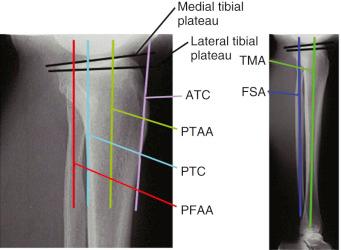
Most authors have measured the medial tibial slope; only a few have measured and provided data on the lateral tibial slope. The lateral tibial slope is less angled than the medial tibial slope. Few investigators have distinguished between the tibial plateau osseous slope and the change that would occur in slope if the articular cartilage and meniscus were added to the calculations. The osseous tibial slope is most commonly noted in the literature and is measured from sagittal radiographs. The true tibial slope, which includes the articular cartilage and meniscus, was noted to be 6 degrees less than the osseous tibial slope according to Jenny and colleagues.
Increasing the tibial slope increases anterior tibial translation and, potentially, tensile loads on the ACL or an ACL reconstruction ( Fig. 26-21 ). Conversely, decreasing the tibial slope theoretically would increase tensile loads on the PCL and shift the tibia to a more anterior position. Shelburne and colleagues studied how changes in posterior tibial slope affected tibial shear force, anterior tibial translation, and knee ligament loading during standing, squatting, and stance-phase walking activities. These authors used a validated computer modeling of the lower extremity and altered the posterior tibial slope in 1-degree increments up to a maximum of 10 degrees of change in slope. The results showed that anterior tibial translation increased as posterior tibial slope increased, and ACL force increased (for standing and walking) as tibial slope increased. It is important to note that the increased ACL force values were in the modest range because ACL force increased by 16 N for each degree of increase in posterior tibial slope. The model predicted a 6-N decrease in PCL force and a 15-N decrease in posterolateral ligament force for each degree increase in posterior tibial slope. Similar results were reported by Marouane and associates who used two finite element models of the knee joint to model the effect of changes in posterior tibial slope on ligament loads and tibial translation and to predict contact pressures of the lateral and medial plateau (under 100-N axial load). The data showed that, at mid stance in the gait model, a change in posterior tibial slope from –5 to +5 degrees resulted in a change in ACL force from –79 to +136 N from the 0 neutral reference point. This corresponded to a change in AP position from –1.2 to +1.2 mm from the 0 neutral position. In comparison, the study by Shelburne and colleagues showed an alteration in posterior tibial slope of –5 to +5 degrees in walking resulted in a change from –75 to +80 N in ACL force, as well as a change from –2.3 to +2.4 mm in anterior tibial translation relative to reference values. Accordingly, these studies show that there is the potential for higher ACL forces on a healing ACL graft substitute with an abnormal tibial slope; however, the increase in forces is in the modest range and well below predicted ACL graft rupture. It would thus be prudent to measure the tibial slope in patients undergoing ACL surgery and determine those outliers (±2 standard deviations) in whom a more conservative rehabilitation program should be used to protect the healing graft in the early to mid postoperative period. This suggestion may even have increased relevance with low-strength ACL grafts that have decreased healing potential, as shown with allografts. Marouane and associates reported in their second finite element model that a 1400-N axial load at 45 degrees of knee flexion at posterior tibial slopes of –5 degrees, neutral 0 degree, and 5 degrees produced calculated ACL forces of 102 N, 181 N, and 317 N, respectively.
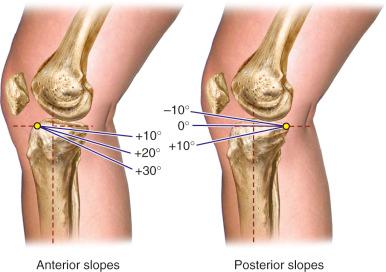
Giffin and coworkers reported in cadaveric knees that an increase of 5 degrees in the tibial slope produced an anterior shift in the resting position of the tibia (maximum, 3.6 mm ± 1.4 mm at full extension). However, under a 200-N axial load, there was only a 2-mm anterior shift in the tibiofemoral contact position (30 and 90 degrees) and no increase in ACL forces. The authors concluded that small changes in tibial slope under simulated weight-bearing conditions would have little effect on tibiofemoral position; however, the 200-N axial load does not simulate larger weight-bearing loads with activity.
In a second study conducted by Giffin and associates, a 5-mm anterior opening wedge osteotomy in PCL-sectioned cadaveric knees was performed, and an anterior shift in the tibia resting position of approximately 4 mm was measured. The beneficial effect of an increase in tibial slope in a PCL-deficient knee should be viewed in terms of functional loading conditions, and it is questionable whether the resting no-load position data are applicable to in vivo loading conditions. In this study, under a combined 134-N tibial translation load and 200-N axial compressive load, there was no statistical difference in the amount of posterior tibial subluxation between the PCL-deficient and PCL-deficient osteotomy knees. The data show that the tibia reached a similar abnormal posterior tibial position (mean, 90 degrees AP translation: intact knee, 10 mm; PCL deficient, 20.6 mm; PCL deficient osteotomy, 20.3 mm). The authors concluded that “increasing the tibial slope would improve stability in the PCL-deficient knee”; however, this would be true only for conditions of no posterior tibial loading not expected in functional activities. The data in this study may be viewed from an opposite standpoint to indicate that PCL graft reconstruction is warranted in symptomatic knees because the opening wedge osteotomy is not effective in preventing posterior tibial subluxation under posterior tibial loading conditions.
In cadaveric knees, Agneskirchner and colleagues studied the effect of an opening wedge osteotomy combined with a flexion osteotomy (to change the tibial slope) on tibiofemoral contact pressures and the resultant tibiofemoral position. The study reported that the flexion osteotomy shifted the tibiofemoral contact to a more anterior position (15 degrees of flexion osteotomy, ~5 mm, 30 degrees of knee flexion) that neutralized the effect of sectioning the PCL and reduced pressures of the posterior half of the tibial plateau. The authors suggested in varus-angulated, PCL-deficient knees with associated posterolateral knee ligament injury and knee hyperextension that an associated change in tibial slope would have a beneficial effect. Only quadriceps-induced leg extension loading was used without weight-bearing loads or posterior translational loads that are required to determine the resultant tibiofemoral position under more physiologic loading conditions. The quadriceps loading (to resist the applied external flexion moment) changed with the quadriceps extension force, nearly doubling with the flexion osteotomy (without osteotomy, ~550 N, with 15 degrees of flexion; with osteotomy, ~1100 N quadriceps applied load). In fact, the increased quadriceps loading increased joint contact pressures.
In contrast to the study just discussed, Rodner and coworkers reported in cadaveric knees that an increase in tibial slope in the ACL-deficient knee at the time of an HTO has the potential to redistribute tibiofemoral contact pressures to a more posterior position on the tibial plateau. From a theoretical standpoint, a redistribution of pressures posterior on the tibial plateau would be detrimental to the long-term success of an HTO in ACL-deficient knees with meniscectomy and posterior tibial plateau articular damage. The cadaver knee studies involved uniaxial loading knee joint loads instead of the quadriceps loading in the study by Agneskirchner and colleagues, thereby demonstrating the marked effect that in vitro experimental loading conditions have on joint contact pressures and study conclusions.
Brandon and associates measured the tibial slope in 100 ACL-deficient patients and 100 controls and reported that female and male patients had similar tibial slope measurements. ACL-deficient female and male patients had increases in tibial slope (mean values increased 3.6 degrees and 2.4 degrees, respectively), and the high-grade pivot shift patient group had an increase in tibial slope (mean value increased ~2 degrees). The measurements show high standard deviations (~35% of the mean values), and it is probable that the few degrees difference among patient groups are not clinically significant or would result in increased ACL load and anterior tibial displacement.
Dejour and colleagues evaluated chronic ACL-deficient knees with monopodal lateral weight-bearing films (knee flexed 20 to 30 degrees with the quadriceps contracted) and compared the anterior tibial translation with the tibial slope. The tibial slope was defined as the angle between the medial tibial plateau and the long axis of the tibia, which had an average value of 6 degrees. The anterior tibial translation was defined as the distance between a parallel line at the posterior medial tibial plateau and a posterior point on the medial femoral condyle. The authors reported a statistically significant relationship between the standing anterior tibial translation and the tibial slope in both normal and chronic ACL-deficient knees. The regression line showed a 6 mm increase in anterior tibial translation for every 10-degree increase in tibial slope. However, it should be noted that a wide variation was present in the data between knees. For example, in chronic ACL-deficient knees with a tibial slope of 10 degrees, anterior tibial translation varied from approximately –2 to 12 degrees.
Griffin and Shannon summarized the clinical role of HTO with knee ligament instability, showing the benefit of an anterior opening wedge HTO for severe recurvatum and correcting an abnormal increased tibial slope in select patients who had failed multiple ligament reconstructions.
Marti and coworkers recommended that knees with ACL insufficiency and associated medial arthritis with a tibial slope of 10 degrees or more undergo correction at the time of a varus-producing osteotomy. However, no clinical data were provided to demonstrate whether a change in slope decreased instability symptoms. Other authors have discussed increases in ACL tensile loads when tibial slope exceeded 10 degrees and postulated the need for correction, again without clinical data.
Griffin and Shannon noted that the anterior tibial subluxation with ACL insufficiency results in a “copula” owing to increased damage of the medial plateau; however, the effect of a medial meniscectomy on producing the same effect should be considered.
We agree with recommendations to correct tibial slope when a distinct abnormality is present ( Figs. 26-22 and 26-23 ). The published literature does not provide objective data regarding the degrees of abnormal increase or decrease in tibial slope when corrective osteotomy is indicated where there is an associated ACL or PCL insufficiency.
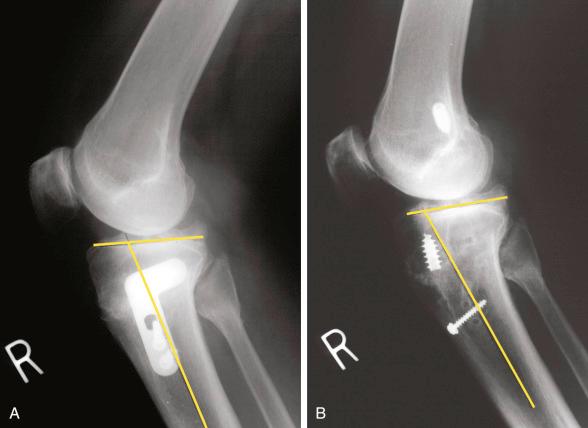
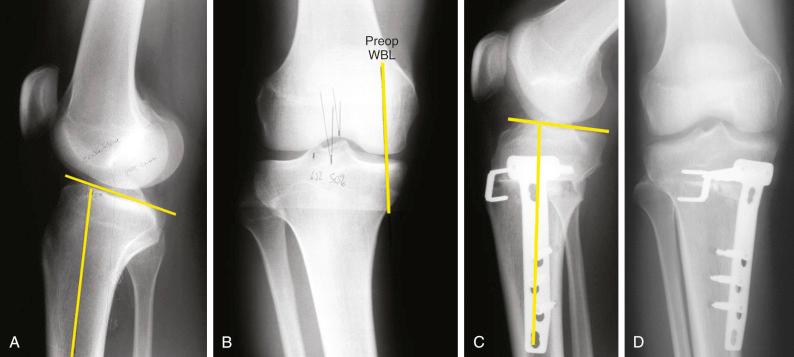
It is probable that a change in AP shear forces, cruciate tensile loads, and tibiofemoral contact under dynamic conditions would not have clinical significance after a 5-degree change in the tibial slope when the preoperative tibial slope is in the normal range. Therefore changing the tibial slope to alter the tibiofemoral contact position by a few millimeters to produce an anterior or posterior shift in tibia position (to an area of less cartilage damage) has theoretical benefits but has not been proven in clinical studies to be adopted as a treatment recommendation.
There are patients who have a distinctly abnormal tibial slope from a prior osteotomy, tibial fracture, or growth abnormality or an underlying genetic variability in which correction of the tibial slope is required before cruciate ligament surgery or other conditions discussed. Occasionally, ACL revision patients have an abnormally increased slope that should be corrected before ACL revision surgery. Empirically, a tibial slope 2 standard deviations above normal or more (based on the method) may be considered for correction. In these knees, at the time of HTO, it is possible to decrease the tibial slope to normal or below normal in ACL-deficient knees, or to increase the slope in PCL-deficient knees to alter loads on the respective cruciate ligament and possibly change the abnormal resting tibiofemoral weight-bearing position.
A normal tibial slope should not be altered in ACL-deficient knees or PCL-deficient knees undergoing a varus-producing opening wedge osteotomy. The rule is described elsewhere in this chapter (Opening Wedge Osteotomy: Preservation of Tibial Slope) that the anterior gap at the medial opening wedge should be one half of the posteromedial gap to maintain a normal tibial slope. For every 1 mm of anterior gap change, an approximate 2-degree change in tibial slope would be produced. This is based on the angle of the anteromedial tibial cortex, the tibial width, and the AP distance where the gap measurement is made (see Table 26-5 ). It is common in opening wedge osteotomies to incorrectly produce a symmetrical anterior and posterior gap at the osteotomy site, which results in a considerable increase in the tibial slope, potentially leading to a decrease in knee extension and increase in ACL tensile loads. For example, a change in the tibial slope by 10 degrees would result if an anterior gap measurement error of only 5 mm occurred. The final tibial slope is verified at surgery by lateral fluoroscopic views.
If the surgeon elects to decrease the tibial slope, a staple may be placed at the tibial tubercle after the osteotomy is carefully closed anteriorly to the desired amount. In the senior author's experience, biplanar corrections require the use of a secure locking plate design to maintain the correction because it is necessary to extend the osteotomy through the lateral tibial cortex to close the anterior osteotomy gap ( Fig. 26-24 ). Caution is required when closing the anterior osteotomy gap to apply only gentle hyperextension pressure on the tibia. If any resistance is obtained, it is necessary to be sure the posterolateral tibial cortex has been osteotomized to prevent a lateral tibial plateau fracture from occurring just anterior to the remaining posterolateral cortex.
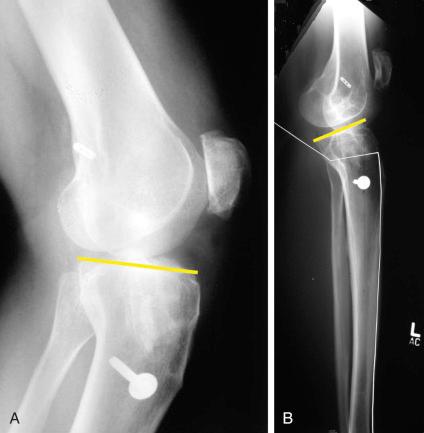
Song and associates reported that the normal tibial slope would be maintained if the gap or millimeters of opening along the anteromedial cortex of the anterior plate was two thirds the gap at the location of the posterior plate. The reader should note that the authors are referring to the location of two plates placed along the anteromedial tibial cortex and not the most posterior and anterior gap of the tibial opening wedge discussed in a Noyes and colleagues study (anterior gap 50% of posterior gap). The data of Noyes and colleagues' study allow the gap to be computed along the entire anteromedial cortex. The Song et al study does not specify where the two plates are placed, whereas data of the Noyes and colleagues' study show the actual gap distance where one or two plates would be placed.
Hohmann and coworkers retrospectively reviewed the radiographs of 67 patients who had a closing wedge HTO and reported a mean decrease of 4.9 degrees in the tibial slope. They suggested that this occurred because of the triangular geometry of the tibia, with a larger width of bone removed from the anterolateral portion of the lateral tibia.
The timing of HTO and ligament reconstructive procedures is based on several factors ( Table 26-4 and Fig. 26-25 ). In primary varus knees that do not demonstrate abnormal lateral joint opening and external tibial rotation, the HTO and cruciate reconstruction may be performed at the same setting. In double and triple varus knees, the ligament reconstructive procedures are performed after the HTO to reduce the risk of complications. Prolonged rehabilitation and an increased risk of knee arthrofibrosis and motion problems have been described after HTO and ligament reconstructive procedures are performed simultaneously.
| Ligament Deficiency | Surgical Procedure | Timing Related to HTO | Indications/Comments |
|---|---|---|---|
| ACL | Autograft * :
|
With HTO only in primary varus knees that do not have abnormal lateral joint opening. Stage HTO double, triple varus knees. | Any patient who had instability before HTO and who should not risk a further trial of function and possible reinjury Consider when secondary ligamentous restraints are lost (pivot shift III + impingement, >10 mm increased anterior displacement involved knee) and with associated medial or FCL, PL deficiency. When meniscus repair is performed; athletically active patient desiring best knee possible for return to sports |
|
|||
| FCL, PMTL (PL structures partial injury, increase 5-mm lateral joint opening, 5-10 degrees external rotation) | Usually not required after HTO. Confirm negative gap test for abnormal lateral joint opening if ACL reconstruction required (primary vs. double varus knee). | Avoid FCL reconstruction | Expect adaptive shortening of FCL, lateral tissues in majority after valgus producing osteotomy. Prefer opening wedge HTO. If closing wedge HTO, avoid disrupting tibiofibular joint, with proximal migration and laxity of PL structures. |
| FCL, PMTL, PL capsule complete deficiency |
|
Staged procedure: HTO first, followed by combined ACL, FCL/PMTL anatomic reconstruction | Usually have increased lateral joint opening of 8 mm at the intercondylar notch (≥12 mm at periphery), increased external tibial rotation of 15 degrees, varus recurvatum, requiring PL reconstruction. PL and ACL reconstructions always performed together. |
* Ipsilateral or contralateral autogenous grafts preferred over allografts.
† We prefer allografts with bone compared with anterior tibialis.
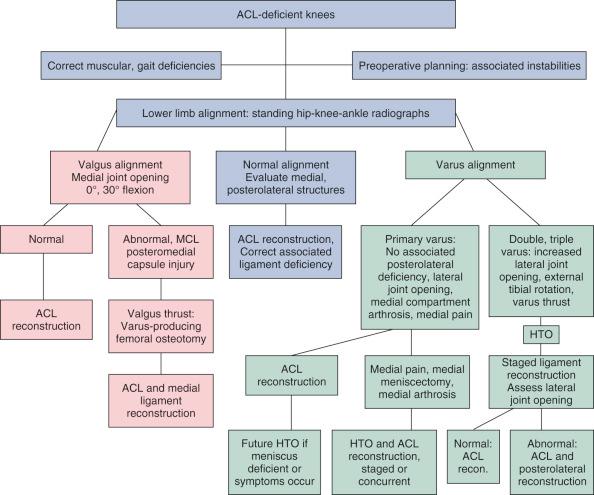
We prefer to perform the HTO first and, after adequate healing of the osteotomy, the required ligament reconstructive procedures are performed. In ACL-deficient double varus knees, an increase in the lateral tibiofemoral joint gap test contraindicates ACL reconstruction. HTO is effective in decreasing abnormal loads in the lateral and posterolateral tissues, allowing physiologic remodeling and shortening to occur, particularly when the deficiency of the posterolateral structures is only moderate (5 to 8 mm of increased lateral joint opening, 10 degrees of increased external tibial rotation). In a study conducted by us, described later in this chapter, 22 of 41 double varus knees (54%) had abnormally increased lateral joint opening on varus stress testing before osteotomy. Of these, only five (12%) had this abnormal joint opening at follow up. An FCL and posterolateral reconstruction was avoided in many patients. A subgroup of 11 patients (27%) did not require ACL reconstruction because instability symptoms did not exist after the HTO.
In triple varus knees, the ACL and posterolateral structures are reconstructed after the HTO to allow all ligament structures to function together to resist anterior subluxation, abnormal lateral tibiofemoral joint opening, and varus recurvatum. These represent major surgical procedures that are always staged and not combined with the HTO.
A four-strand semitendinosus-gracilis (STG) autograft may be harvested from the involved side with little morbidity. Most patients undergoing HTO will not be involved in strenuous athletics, and a STG autograft provides suitable stability for light recreational activities. In revision knees, a STG graft may be used if there are no enlarged femoral or tibial tunnels.
A bone-patellar tendon-bone (B-PT-B) autograft is preferred if there is gross anterior subluxation (grade III pivot shift). In knees undergoing revision ACL reconstruction in which the ipsilateral patellar tendon was previously harvested, the contralateral B-PT-B graft or the ipsilateral quadriceps tendon-patellar bone (QT-PB) graft are preferred substitutes. However, care must be taken when harvesting these autografts from the same knee at the time of the osteotomy. The opposite knee may be used for graft harvest.
The use of allografts for ACL reconstruction is controversial owing to the higher graft stretch-out and failure rates compared with bone-patellar tendon-bone autografts as discussed in detail in Chapters 7 and 8 . If an allograft is required, the B-PT-B has an advantage of more secure bone fixation.
Graft preferences for PCL reconstruction are a two-strand QT-PB autograft or allografts, further described in Chapter 16 . The options for surgical restoration of deficient posterolateral structures are described in Chapter 17 .
The two most common operative techniques for correcting a varus deformity are the opening and the closing wedge tibial osteotomies. An opening wedge avoids the lateral dissection and fibular osteotomy. Knees that require a large angular correction of greater than 12 degrees are candidates for the opening wedge procedure because it avoids excessive tibial shortening.
Opening wedge osteotomy is advantageous in knees that have chronic medial ligamentous deficiency (MCL, posteromedial capsule), in which a distal advancement or reconstruction of the MCL is required. Knees with rupture of the posterolateral structures requiring posterolateral reconstruction are candidates for opening wedge osteotomy to avoid a proximal fibular osteotomy because an FCL graft will be anchored to the proximal fibula. Opening wedge osteotomy is advantageous in cases of patella alta or decreased lower limb length which would be made worse by a closing wedge osteotomy. A significant patella infera is a relative contraindication for an opening wedge osteotomy. A significant patella alta is a relative contraindication for a closing wedge osteotomy.
The major disadvantage of an opening wedge osteotomy is that an appropriate structural corticancellous autograft or allograft is required to restore the anteromedial and posteromedial cortex, add fixation strength, and promote osseous union (with major corrections). Autogenous bone grafting of the open defect aids in promoting prompt union with reduced risk of varus collapse caused by a delayed union.
Several opening wedge plate designs are available. We prefer a tibial plate with locking screws to achieve secure osseous fixation. The reader is referred to the appropriate literature by the respective manufacturer, because each locking plate design is different and the recommended technique must be followed. There are rules that must be followed to avoid changing the tibial slope with the use of any fixation plate. A greater chance of increasing the posterior tibial slope exists if an opening wedge buttress plate is placed in an anterior position. With attention to this problem during surgery, the normal tibial slope in the sagittal plane can be preserved with any of the available plate designs.
A disadvantage of an opening wedge osteotomy is that transection of the superficial distal attachment of the MCL is required. In an opening wedge osteotomy of 5 mm, the MCL fibers may be incompletely transected at several different levels (pie-crust approach) to lengthen the ligament. However, osteotomies entailing a correction greater than 5 mm require distal MCL sectioning, careful reflection from the osteotomy site, and reattachment.
The closing wedge osteotomy has the advantage of faster healing and early resumption of weight bearing because contact of two large cancellous surfaces of the proximal tibia is achieved. The initial interval fixation of the osteotomy is more secure than an opening wedge procedure, and there is less chance for a change in osteotomy position and loss of correction. It is more difficult (compared with the opening wedge technique) to achieve or change the desired amount of bone resection to obtain accurate angular alignment correction at surgery.
The closing wedge osteotomy involves more soft tissue dissection. Osteotomy of the fibula is preferred at the proximal fibular neck region. The lateral dissection must be meticulous to avoid the peroneal nerve. It is more tedious to resect more bone and alter the lower limb valgus correction if it is necessary to achieve additional angular correction. The triangular bone wedge is removed and saved in case it is necessary to reinsert bone during the procedure if an overcorrection occurs.
Brouwer and associates conducted a prospective clinical trial in 92 patients randomized to either an opening wedge (Puddu plate) or a closing wedge osteotomy. At 1 year postoperatively, a valgus alignment (defined as 0 to 6 degrees valgus) was noted in 79% of the closing wedge osteotomies compared with 56% of the opening wedge osteotomies. The authors concluded that the Puddu plate had insufficient strength to maintain the operative correction. The investigation had several flaws because it involved four surgeons, and hip-knee-ankle radiographs were not obtained in the initial postoperative period. The number of opening wedge osteotomies that received autogenous bone grafting was not provided. The results emphasize the importance of determining that the appropriate valgus correction is achieved during surgery and maintained in the early postoperative period until union has occurred. The failure to achieve the desired valgus alignment would be expected to decrease long-term success rates. Full-standing weight-bearing hip-knee-ankle radiographs may be obtained by 3 to 4 weeks postoperative after either opening or closing wedge osteotomy to verify that correction has been achieved. In a small percentage of cases in which the correction is found not to be ideal on early postoperative radiographs, a revision angular correction may then be performed.
The use of an external fixator has been advocated with tibial osteotomy, with the advantage of allowing adjustments in lower limb alignment that is helpful in difficult or biplanar corrections. Disadvantages of an external fixator are the risk of pin tract infection and the 12-week period that the fixator is typically used. The use of an external fixator is ideal when both coronal lower limb alignment and tibial rotation need to be corrected.
On cross-section, the proximal anteromedial tibial cortex has an oblique or triangular shape, whereas the lateral tibial cortex is more perpendicular at the posterior margin of the tibia. Because of this relationship, a medial opening wedge osteotomy that has an anterior tibial tubercle width equal to the width at the posteromedial margin would increase tibial slope, decrease knee extension, and possibly increase ACL tensile loads. A lateral closing wedge osteotomy with an equal anterior-to-posterior width or gap along the lateral tibial cortex tends to decrease the tibial slope by a few degrees, as is described next.
A study was conducted using 3-dimensional analysis of the proximal tibia to determine how the angle of the opening wedge along the anteromedial tibial cortex influences the tibial slope (sagittal plane) and valgus correction (coronal plane) when performing a medial opening wedge osteotomy.
The data in this study on the obliquity of the anteromedial cortex of the proximal tibia relative to the posterior tibial cortex ( Fig. 26-26 ) are presented from 35 magnetic resonance imaging (MRI) films in healthy young individuals (mean age, 32.7 years). Serial CT images of a cadaveric tibia were made in 1.25-mm slices and digitized using a computer-aided design package to create a solid model of the proximal tibia.
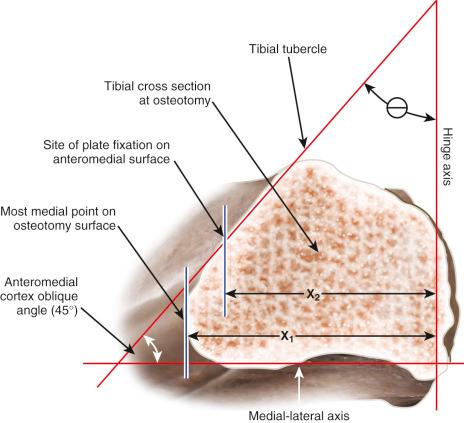
A medial opening wedge osteotomy was created along the AP axis to include a hinge axis on the lateral margin of the tibia. The open wedge osteotomy was just proximal to the tibial tubercle, ending 20 mm below the cortical margin of the lateral tibial plateau. The distal portion of the tibia was rotated on the virtual model about the hinge axis through the lateral point of the osteotomy maintaining the anatomic tibial slope (sagittal plane). Measurements of the width of the wedge angle and gap angle ( Fig. 26-27 ) along the anteromedial tibial cortex were made from the resulting computerized model. Standard algebraic calculations were made using the law of triangles to determine the effect of different degrees of opening wedge osteotomy on coronal (valgus) and sagittal (tibial slope) alignment.
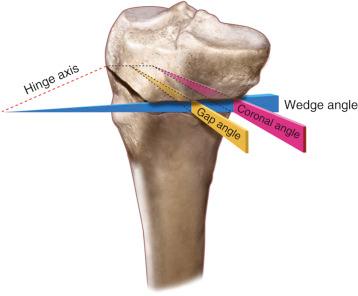
The MRI measurement of the anteromedial tibial cortex oblique angle at the site of the opening wedge osteotomy was 45 ± 6 degrees (range, 34-56 degrees). The opening wedge angle, along the anteromedial tibial cortex to maintain the tibial slope, was found to be dependent on the angle of coronal valgus correction (HTO coronal angle) and the angle of obliquity of the anteromedial tibial cortex. In Figure 26-28 , the results are shown for the calculation of the opening wedge angle (along the anteromedial tibial cortex) for five different osteotomy corrections in the coronal valgus plane (2.5-12.5 degrees).
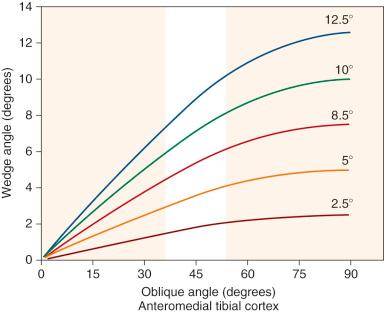
The gap angle is perpendicular to the anteromedial oblique surface of the tibia with a vertex on the hinge axis posterior to the tibia. This is shown in Figure 26-29 , in which the gap angle in degrees is shown for five different osteotomy corrections as a function of the obliquity of the anteromedial tibial cortex.
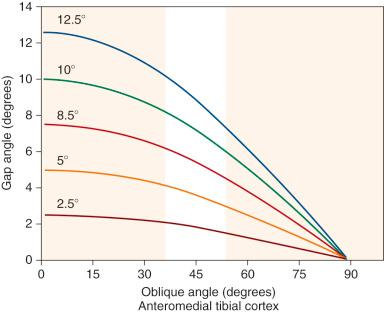
As an example, a 10-degree coronal valgus correction (assuming a normal 45-degree obliquity of the anteromedial tibial cortex) would result in a 7-degree gap angle at the osteotomy site. An error in the anteromedial tibial cortex opening wedge angle would result in an error in the tibial slope. An example of this is shown in Figure 26-30 , which represents the desired wedge angle for a 10-degree coronal correction. An equal anterior and posterior opening or gap at the osteotomy site would result in an increased tibial slope and loss of normal knee extension.
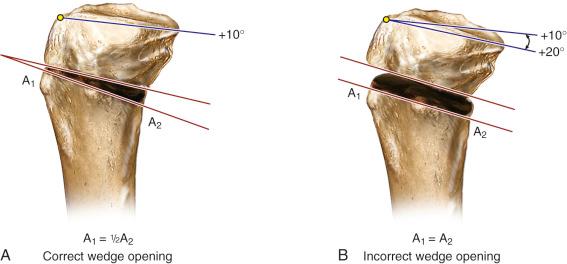
These variables are shown in Table 26-5 . For example, an error of 5 mm in the Y 2 gap ( Fig. 26-31 ) at the tibial tubercle, assuming the length of the anteromedial cortex (L) is 45 mm, would result in an unexpected change in the tibial slope of 10 degrees. As a general rule in this example, every millimeter of alteration in the gap height induces a change of 2 degrees in the tibial slope.
| Error at Y 2 (mm) | LENGTH OF ANTEROMEDIAL CORTEX (mm) | |||||||
|---|---|---|---|---|---|---|---|---|
| 25 | 30 | 35 | 40 | 45 | 50 | 55 | 60 | |
| 1 | 4 | 3.2 | 2.7 | 2.3 | 2 | 1.8 | 1.6 | 1.5 |
| 2 | 8.1 | 6.5 | 5.4 | 4.6 | 4 | 3.6 | 3.2 | 2.9 |
| 3 | 12 | 9.6 | 8.1 | 6.9 | 6.1 | 5.4 | 4.9 | 4.4 |
| 4 | 15.8 | 12.8 | 10.7 | 9.2 | 8.1 | 7.2 | 6.5 | 5.9 |
| 5 | 19.5 | 15.8 | 13.3 | 11.4 | 10 | 8.9 | 8.1 | 7.3 |
| 6 | 23 | 18.8 | 15.8 | 13.6 | 12 | 10.7 | 9.6 | 8.8 |
| 7 | 26.3 | 21.6 | 18.3 | 15.8 | 13.9 | 12.4 | 11.2 | 10.2 |
| 8 | 29.5 | 24.4 | 20.7 | 17.9 | 15.8 | 14.4 | 12.8 | 11.6 |
| 9 | 32.5 | 27 | 23 | 20 | 17.7 | 15.8 | 14.3 | 13 |
| 10 | 35.3 | 29.5 | 25.2 | 22 | 19.5 | 17.4 | 15.8 | 14.4 |
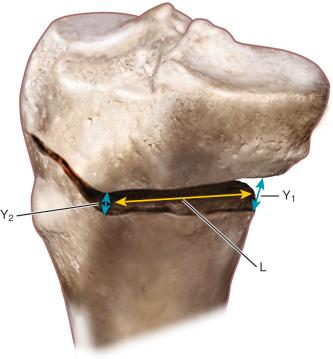
The opening wedge angle can be set at surgery by measuring and altering the vertical gap (width) at two points along the osteotomy site, Y 1 and Y 2 ( Fig. 26-32 ). This has importance in determining that the correct wedge angle is obtained before internal fixation at the osteotomy site. The site at which the vertical gap measurement is taken depends on the coronal distance from the hinge axis, the obliquity of the anteromedial tibial cortex, and the distance along the osteotomy site on the anteromedial surface ( Tables 26-6 and 26-7 ).
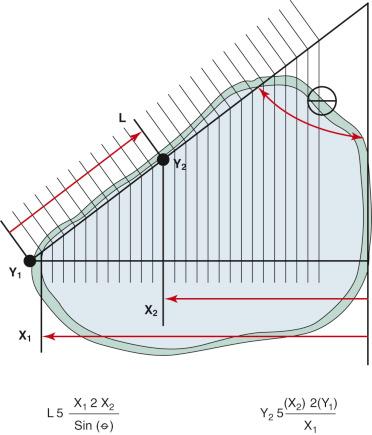
| TW | ANGULAR CORRECTION (DEGREES) | ||||||||
|---|---|---|---|---|---|---|---|---|---|
| 5 | 6 | 7 | 8 | 9 | 10 | 11 | 12 | 13 | |
| 50 | 4.37 | 5.25 | 6.15 | 7 | 8 | 8.8 | 9.7 | 10.85 | 11.55 |
| 55 | 4.81 | 5.78 | 6.77 | 7.7 | 8.8 | 9.68 | 10.67 | 11.94 | 12.71 |
| 60 | 5.25 | 6.3 | 7.38 | 8.4 | 9.6 | 10.56 | 11.64 | 13.02 | 13.86 |
| 65 | 5.69 | 6.83 | 8 | 9.1 | 10.4 | 11.44 | 12.61 | 14.11 | 15.02 |
| 70 | 6.12 | 7.35 | 8.61 | 9.8 | 11.2 | 12.32 | 13.58 | 15.19 | 16.17 |
| 75 | 6.56 | 7.88 | 9.23 | 10.5 | 12 | 13.2 | 14.55 | 16.28 | 17.33 |
| 80 | 7 | 8.4 | 9.84 | 11.2 | 12.8 | 14.08 | 15.52 | 17.36 | 18.48 |
| 85 | 7.44 | 8.93 | 10.46 | 11.9 | 13.6 | 14.96 | 16.49 | 18.45 | 19.64 |
| 90 | 7.87 | 9.45 | 11.07 | 12.6 | 14.4 | 15.84 | 17.46 | 19.53 | 20.79 |
| 95 | 8.31 | 9.98 | 11.69 | 13.3 | 15.2 | 16.72 | 18.43 | 20.62 | 21.95 |
| 100 | 8.75 | 10.5 | 12.3 | 14 | 16 | 17.6 | 19.4 | 21.7 | 23.1 |
| Opening at Osteotomy (Y 1 ) | L | TIBIAL WIDTH | ||||
|---|---|---|---|---|---|---|
| 50 | 55 | 60 | 65 | 70 | ||
| 8 | 0 | 8 | 8 | 8 | 8 | 8.0 |
| 20 | 5.7 | 5.9 | 6.1 | 6.3 | 6.4 | |
| 25 | 5.2 | 5.4 | 5.6 | 5.8 | 6 | |
| 30 | 4.6 | 4.9 | 5.2 | 5.4 | 5.6 | |
| 35 | 4 | 4.4 | 4.7 | 5 | 5.2 | |
| 40 | 3.5 | 3.9 | 4.2 | 4.5 | 4.8 | |
| 45 | 2.9 | 3.4 | 3.8 | 4.1 | 4.4 | |
| 10 | 0 | 10 | 10 | 10 | 10 | 10 |
| 20 | 7.2 | 7.4 | 7.6 | 7.8 | 8 | |
| 25 | 6.5 | 6.8 | 7.1 | 7.3 | 7.5 | |
| 30 | 5.8 | 6.1 | 6.5 | 6.7 | 7 | |
| 35 | 5.1 | 5.5 | 5.9 | 6.2 | 6.5 | |
| 40 | 4.3 | 4.9 | 5.3 | 5.6 | 6 | |
| 45 | 3.6 | 4.2 | 4.7 | 5.1 | 5.5 | |
| 12 | 0 | 12 | 12 | 12 | 12 | 12 |
| 20 | 8.6 | 8.9 | 9.2 | 9.4 | 9.6 | |
| 25 | 7.8 | 8.1 | 8.5 | 8.7 | 9 | |
| 30 | 6.9 | 7.4 | 7.8 | 8.1 | 8.4 | |
| 35 | 6.1 | 6.6 | 7.1 | 7.4 | 7.8 | |
| 40 | 5.2 | 5.8 | 6.3 | 6.8 | 7.2 | |
| 45 | 4.4 | 5.1 | 5.6 | 6.1 | 6.5 | |
In Table 26-6 , the millimeters of opening at the osteotomy site are based on the width of the tibia and the angle of correction. In Table 26-7, an average 45-degree oblique angle of the anteromedial cortex and a tibial width of 60 mm are assumed. This allows the surgeon to calculate at the time of surgery the desired gap height at two points along the osteotomy to maintain the tibial slope.
For example, the measurement of the posterior tibial width is made at the osteotomy site (X 1 ). The opening height at the most posteromedial point (Y 1 ) and the distance between the two measurement points (Y 1 -Y 2 ) are used in Table 26-7 to determine the second opening height at a defined distance (L) along the osteotomy site to maintain tibial slope.
If the tibial plate is placed just anterior to the superficial MCL on the anteromedial tibial cortex, approximately 20 mm anterior to the most posteromedial point of the osteotomy, the osteotomy gap at this site can be determined in Table 26-7 , with a 10-mm posteromedial opening (Y 1 ), the correct width at the tibial plate would be 7.6 mm (tibial width, 60 mm).
For a 12-mm posteromedial opening, the correct width of the gap at the tibial plate would be 9.2 mm. A wider gap at the tibial plate would result in excessive valgus alignment and altered tibial slope. The change in the oblique angle of the anteromedial cortex, within the standard deviations reported, would have only a small and negligible effect on the width measurements of the opening wedge (see Table 26-7 ). To maintain the proper anterior and posterior gaps at the osteotomy site, appropriate distraction instruments at surgery are required to maintain the desired coronal and sagittal angular correction.
Determine the coronal valgus angular correction in degrees based on preoperative full-standing radiographs for the desired placement of the WBL at the tibial plateau and measure the tibial slope based on a lateral radiograph.
Determine the millimeters of opening at the posteromedial osteotomy site at surgery (Y 1 gap) using the width of the tibia (X 1 distance) for the coronal valgus correction based on the law of triangles (first triangle; see Table 26-6 ).
Determine the proper gap width of the osteotomy opening wedge along the anteromedial cortex to maintain tibial slope and the proper width beneath the tibial plate based on its location along the anteromedial cortex (see Table 26-7 ). The opening wedge gap will always be 3 to 4 mm less where the plate is located. If the tibial slope is to be increased or decreased, the effect on the degrees of tibial slope is shown in Table 26-5 .
Confirm final coronal and sagittal angular correction based on intraoperative fluoroscopy and early postoperative full standing and lateral radiographs.
Repeat all knee ligament subluxation tests under anesthesia on both injured and contralateral limbs.
Become a Clinical Tree membership for Full access and enjoy Unlimited articles
If you are a member. Log in here